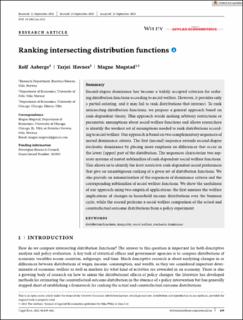| dc.contributor.author | Aaberge, Rolf | |
| dc.contributor.author | Havnes, Tarjei | |
| dc.contributor.author | Mogstad, Magne | |
| dc.date.accessioned | 2022-03-21T17:51:51Z | |
| dc.date.available | 2022-03-21T17:51:51Z | |
| dc.date.created | 2021-09-16T13:14:03Z | |
| dc.date.issued | 2021 | |
| dc.identifier.citation | Journal of applied econometrics. 2021, 36 (6), 639-662. | en_US |
| dc.identifier.issn | 0883-7252 | |
| dc.identifier.uri | https://hdl.handle.net/11250/2986631 | |
| dc.description.abstract | Second-degree dominance has become a widely accepted criterion for ordering distribution functions according to social welfare. However, it provides only a partial ordering, and it may fail to rank distributions that intersect. To rank intersecting distribution functions, we propose a general approach based on rank-dependent theory. This approach avoids making arbitrary restrictions or parametric assumptions about social welfare functions and allows researchers to identify the weakest set of assumptions needed to rank distributions according to social welfare. Our approach is based on two complementary sequences of nested dominance criteria. The first (second) sequence extends second-degree stochastic dominance by placing more emphasis on differences that occur in the lower (upper) part of the distribution. The sequences characterize two separate systems of nested subfamilies of rank-dependent social welfare functions. This allows us to identify the least restrictive rank-dependent social preferences that give an unambiguous ranking of a given set of distribution functions. We also provide an axiomatization of the sequences of dominance criteria and the corresponding subfamilies of social welfare functions. We show the usefulness of our approach using two empirical applications; the first assesses the welfare implications of changes in household income distributions over the business cycle, while the second performs a social welfare comparison of the actual and counterfactual outcome distributions from a policy experiment. | en_US |
| dc.language.iso | eng | en_US |
| dc.rights | Navngivelse-Ikkekommersiell-DelPåSammeVilkår 4.0 Internasjonal | * |
| dc.rights.uri | http://creativecommons.org/licenses/by-nc-sa/4.0/deed.no | * |
| dc.title | Ranking intersecting distribution functions | en_US |
| dc.type | Peer reviewed | en_US |
| dc.type | Journal article | en_US |
| dc.description.version | publishedVersion | en_US |
| dc.rights.holder | This is an open access article under the terms of the Creative Commons Attribution License, which permits use, distribution and reproduction in any medium, provided theoriginal work is properly cited.© 2021 The Authors. Journal of Applied Econometrics published by John Wiley & Sons Ltd. | en_US |
| dc.subject.nsi | VDP::Samfunnsvitenskap: 200::Økonomi: 210 | en_US |
| dc.source.pagenumber | 639-662 | en_US |
| dc.source.volume | 36 | en_US |
| dc.source.journal | Journal of applied econometrics | en_US |
| dc.source.issue | 6 | en_US |
| dc.identifier.doi | 10.1002/jae.2832 | |
| dc.identifier.cristin | 1934918 | |
| dc.relation.project | Norges forskningsråd: 261985 | en_US |
| cristin.ispublished | true | |
| cristin.fulltext | original | |
| cristin.qualitycode | 2 | |

